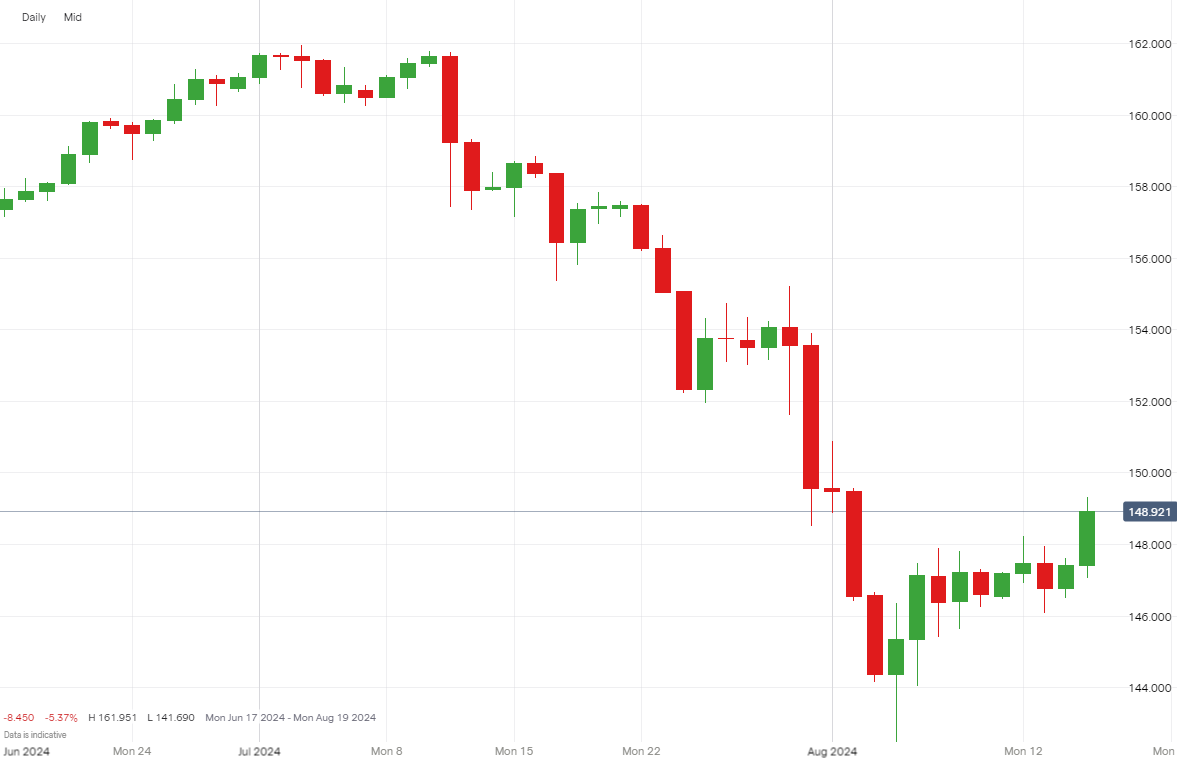USD/JPY breaks through 149.00 after resilient US consumer data
Discover how strong US spending data led to a 1% surge in USD/JPY, pushing it above 149.00. Explore the implications of stronger retail sales, softer September rate cut odds, and rising bond yields on the USD.

Key points
- Retail sales increased by 1.0% in July, the highest since January 2023, quelling recession fears
- USD/JPY surged over 1% to trade above 149.00 for the first time in two weeks
- Futures markets now predict a 25 basis point cut from the Fed in September, down from 50 bps a week ago
- US dollar strengthened as bond yields rose; 2-year Treasury yields up 4% and 10-year yields up 3%
- Consumer sentiment data releases tomorrow at 10:00am EST
Retail sales smash expectations, quelling recession fears
Retail sales surged by 1.0% month-over-month in July, significantly higher than the anticipated 0.3%, marking the strongest performance since January 2023. This comes amid concerns of a potential recession, especially after disappointing employment data earlier in the month showed a 4.3% unemployment rate. The robust retail sales figures have alleviated some fears, boosting market confidence and prompting traders to revisit their economic outlooks.
USD/JPY pops +1% to 149.00
USD/JPY had been trading in the 146.00-148.00 range for the past week, but the strong retail sales report pushed the pair above 149.00 for the first time in two weeks. The dollar gained over 1% against the yen, reflecting renewed optimism in the US economy and expectations of fewer Federal Reserve rate cuts. This movement indicates a positive market response to the unexpectedly strong retail data.
USD/JPY price history

September rate cut odds soften to 25bps
Just a week ago, Fed Funds futures favored a 50 bps cut in September, but current odds now show a 75% chance of a single 25 bps cut. Despite this adjustment, Federal Reserve members seem increasingly supportive of a rate cut as economic indicators balance out. The shift in expectations highlights the market's reaction to improving economic data and the Fed's flexible approach to monetary policy.
US dollar rebounds as bond yields rise
Positive US economic data has caused the dollar to strengthen across the board. EUR/USD dropped below 1.100, while USD/CHF climbed 1% to near 0.8800. Bond yields also rose, with 2-year Treasuries up 4% and 10-year Treasuries up 3%. Higher bond yields have increased demand for the USD, as investors could see higher rates than previously expected for longer, boosting the currency's value.
Consumer sentiment data due tomorrow
Consumer sentiment data, a crucial indicator of future spending, is set to be released tomorrow at 10am EST. This follows the recent CPI inflation report and is expected to show a slight improvement after hitting an 8-month low in July. A positive sentiment reading could further support the USD, while a negative result might cause investor concern and market volatility.
Where next for the US dollar?
While it's clear that rate cuts are expected in September, the USD's future will hinge on the scale of the cuts and the overall economic outlook. If growth prospects appear weak, the dollar may struggle. Conversely, sustained economic growth and robust spending could bolster the dollar, influencing forex trading strategies and market confidence.
How to trade US dollar
- Open an account to get started, or practice on a demo account
- Choose your forex trading platform
- Open, monitor, and close positions on USD pairs
Trading forex requires an account with a forex provider like tastyfx. Many traders also watch major forex pairs like EUR/USD and USD/JPY for potential opportunities based on economic events such as inflation releases or interest rate decisions. Economic events can produce more volatility for forex pairs, which can mean greater potential profits and losses as risks can increase at these times.
You can help develop your forex trading strategies using resources like tastyfx’s YouTube channel. Our curated playlists can help you stay up to date on current markets and understanding key terms. Once your strategy is developed, you can follow the above steps to opening an account and getting started trading forex.
Your profit or loss is calculated according to your full position size. Leverage will magnify both your profits and losses. It’s important to manage your risks carefully as losses can exceed your deposit. Ensure you understand the risks and benefits associated with trading leveraged products before you start trading with them. Trade using money you’re comfortable losing.
